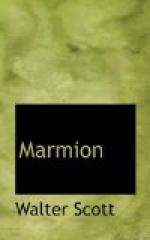“She was pinched,
and pulled, she said,
And he by friar’s
Lanthern led.”
’"The History of Friar Rush” is of extreme rarity, and, for some time, even the existence of such a book was doubted, although it is expressly alluded to by Reginald Scot, in his “Discovery of Witchcraft.” I have perused a copy in the valuable library of my friend Mr. Heber; and I observe, from Mr. Beloe’s “Anecdotes of Literature,” that there is one in the excellent collection of the Marquis of Stafford.’—Scott.
It may be added, on the authority of Keightley, that Friar Rush ’haunted houses, not fields, and was never the same with Jack-o’- the-Lanthorn.’ See note on Milton’s ‘L’Allegro,’ 104, in Clarendon Press edition, also Preface to Midsummer Night’s Dream in same series.
Stanza iv. line 69. Humbie and Saltoun are adjoining parishes in S. W. of Haddingtonshire. To this day there is a charm in the remote rural character of the district. There are, about Humble in particular, wooded glades that might well represent the remains of the scene witnessed by Marmion and his troopers. East and West Saltoun are two decayed villages, about five miles S. W. of the county town. Between them is Saltoun Hall, the seat of the Fletchers.
line 91. ’William Caxton, the earliest English printer, was born in Kent, A. D. 1412, and died 1401. Wynken de Worde was his next successor in the production of those
“Rare volumes, dark with tarnished gold,”
which are now the delight of bibliomaniacs.’—Lockhart.
Stanza vi. line 119. The four heraldic terms used are for the colours—red, silver, gold, and blue.
line 120, The King-at-arms was superintendent of the heralds.
Stanza vii. line 133. Sir David Lyndsay’s exposure of ecclesiastical abuses in his various satires, especially in his ‘Complaynts’ and his Dialog, ’powerfully forwarded the movement that culminated in the Reformation. It would, however, be a mistake to consider him an avowed Protestant reformer. He was concerned about the existing wrongs both of Church and State, and thought of rectifying these without revolutionary measures.
line 135. The cap of the Lion King’ was of scarlet velvet turned up with ermine.’
lines 141-4. The double tressure was an ornamental tracing round the shield, at a fixed distance from the border. As to the fleur-de-lis (flower of the lily, emblem of France) Scott quotes Boethius and Buchanan as saying that it was ’first assumed by Achaius, king of Scotland, contemporary of Charlemagne, and founder of, the celebrated League with France.’ Historical evidence, however, would seem to show that ’the lion is first seen on the seal of Alexander ii, and the tressure on that of Alexander iii.’ This is the heraldic description of the arms of Scotland: ’Or, a lion rampant gules, armed and langued azure, within a double tressure flory counterflory of fleur-de-lis of the second.’ The supporters are ’two unicorns argent maned and unguled, or gorged with open crowns.’ The crest is ‘a lion sejant affronte gules crowned or,’ &c. The adoption of the thistle as the national Scottish emblem is wrapt in obscurity, although an early poet attributes it to a suggestion of Venus.




